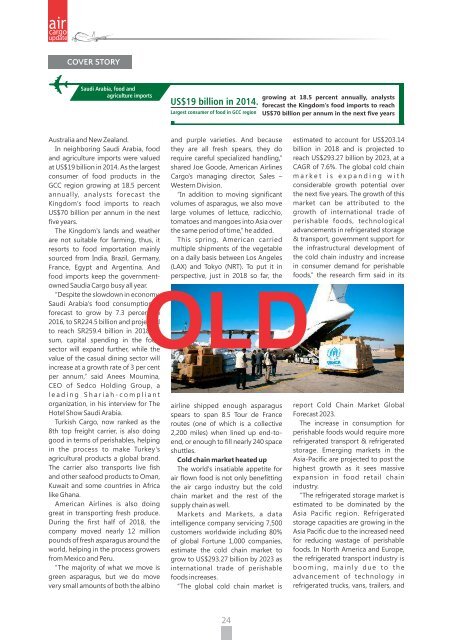You also want an ePaper? Increase the reach of your titles
YUMPU automatically turns print PDFs into web optimized ePapers that Google loves.
COVER STORY<br />
Saudi Arabia, food and<br />
agriculture imports<br />
US$19 billion in 2014.<br />
Largest consumer of food in GCC region<br />
growing at 18.5 percent annually, analysts<br />
forecast the Kingdom's food imports to reach<br />
US$70 billion per annum in the next five years<br />
Australia and New Zealand.<br />
In neighboring Saudi Arabia, food<br />
and agriculture imports were valued<br />
at US$19 billion in 2014. As the largest<br />
consumer of food products in the<br />
GCC region growing at 18.5 percent<br />
annually, analysts forecast the<br />
Kingdom's food imports to reach<br />
US$70 billion per annum in the next<br />
five years.<br />
The Kingdom's lands and weather<br />
are not suitable for farming, thus, it<br />
resorts to food importation mainly<br />
sourced from India, Brazil, Germany,<br />
France, Egypt and Argentina. And<br />
food imports keep the governmentowned<br />
Saudia Cargo busy all year.<br />
“Despite the slowdown in economy,<br />
Saudi Arabia's food consumption is<br />
forecast to grow by 7.3 percent in<br />
2016, to SR224.5 billion and projected<br />
to reach SR259.4 billion in 2018. In<br />
sum, capital spending in the food<br />
sector will expand further, while the<br />
value of the casual dining sector will<br />
increase at a growth rate of 3 per cent<br />
per annum,” said Anees Moumina,<br />
CEO of Sedco Holding Group, a<br />
l e a d i n g S h a r i a h - c o m p l i a n t<br />
organization, in his interview for The<br />
Hotel Show Saudi Arabia.<br />
Turkish Cargo, now ranked as the<br />
8th top freight carrier, is also doing<br />
good in terms of perishables, helping<br />
in the process to make Turkey's<br />
agricultural products a global brand.<br />
The carrier also transports live fish<br />
and other seafood products to Oman,<br />
Kuwait and some countries in Africa<br />
like Ghana.<br />
American Airlines is also doing<br />
great in transporting fresh produce.<br />
During the first half of 2018, the<br />
company moved nearly 12 million<br />
pounds of fresh asparagus around the<br />
world, helping in the process growers<br />
from Mexico and Peru.<br />
“The majority of what we move is<br />
green asparagus, but we do move<br />
very small amounts of both the albino<br />
and purple varieties. And because<br />
they are all fresh spears, they do<br />
require careful specialized handling,”<br />
shared Joe Goode, American Airlines<br />
Cargo's managing director, Sales –<br />
Western Division.<br />
“In addition to moving significant<br />
volumes of asparagus, we also move<br />
large volumes of lettuce, radicchio,<br />
tomatoes and mangoes into Asia over<br />
the same period of time,” he added.<br />
This spring, American carried<br />
multiple shipments of the vegetable<br />
on a daily basis between Los Angeles<br />
(LAX) and Tokyo (NRT). To put it in<br />
perspective, just in 2018 so far, the<br />
OLD<br />
airline shipped enough asparagus<br />
spears to span 8.5 Tour de France<br />
routes (one of which is a collective<br />
2,200 miles) when lined up end-toend,<br />
or enough to fill nearly 240 space<br />
shuttles.<br />
Cold chain market heated up<br />
The world's insatiable appetite for<br />
air flown food is not only benefitting<br />
the air cargo industry but the cold<br />
chain market and the rest of the<br />
supply chain as well.<br />
Markets and Markets, a data<br />
intelligence company servicing 7,500<br />
customers worldwide including 80%<br />
of global Fortune 1,000 companies,<br />
estimate the cold chain market to<br />
grow to US$293.27 billion by 2023 as<br />
international trade of perishable<br />
foods increases.<br />
“The global cold chain market is<br />
estimated to account for US$203.14<br />
billion in 2018 and is projected to<br />
reach US$293.27 billion by 2023, at a<br />
CAGR of 7.6%. The global cold chain<br />
m a r k e t i s e x p a n d i n g w i t h<br />
considerable growth potential over<br />
the next five years. The growth of this<br />
market can be attributed to the<br />
growth of international trade of<br />
perishable foods, technological<br />
advancements in refrigerated storage<br />
& transport, government support for<br />
the infrastructural development of<br />
the cold chain industry and increase<br />
in consumer demand for perishable<br />
foods,” the research firm said in its<br />
report Cold Chain Market Global<br />
Forecast 2023.<br />
The increase in consumption for<br />
perishable foods would require more<br />
refrigerated transport & refrigerated<br />
storage. Emerging markets in the<br />
Asia-Pacific are projected to post the<br />
highest growth as it sees massive<br />
expansion in food retail chain<br />
industry.<br />
“The refrigerated storage market is<br />
estimated to be dominated by the<br />
Asia Pacific region. Refrigerated<br />
storage capacities are growing in the<br />
Asia Pacific due to the increased need<br />
for reducing wastage of perishable<br />
foods. In North America and Europe,<br />
the refrigerated transport industry is<br />
b o o m i n g , m a i n l y d u e t o t h e<br />
advancement of technology in<br />
refrigerated trucks, vans, trailers, and

















